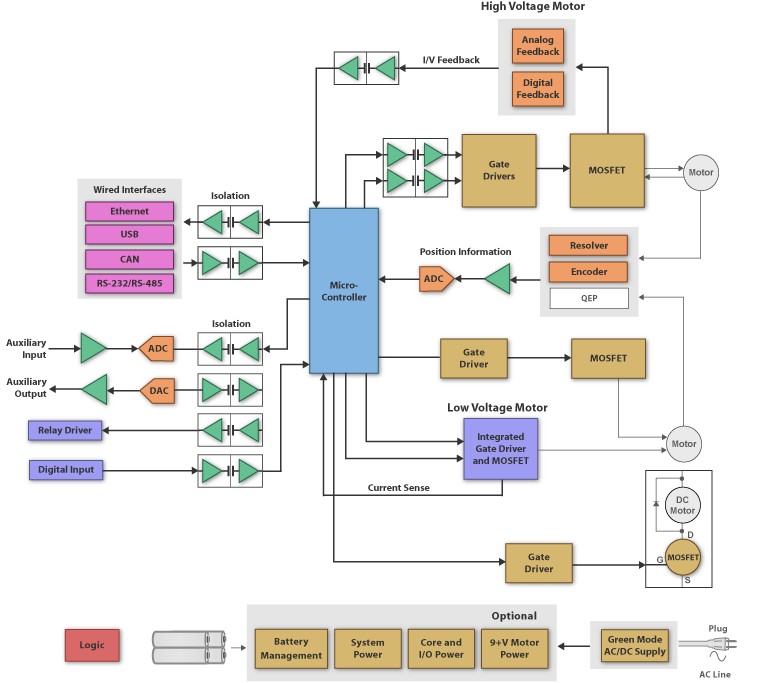Texas Instruments Low Voltage Motor Control Solution
Block diagram

Design considerations
Small electromechanical drives include solenoid-driven, unidirectional DC, bidirectional DC or brushless DC systems, which are typically sized according to frame size and power (in watts). TI's digital controllers, software and auxiliary analog and digital solutions help meet most drive requirements.
The kernel subsystem includes:
Controller:
TI offers a variety of solutions for controlling processors; from ultra-low-power MSP430 microprocessors to ARMTM Hercules®-based CortexTM-R4F safety MCUs and C2000 digital signal controllers (DSCs). A suitable controller can optimize motor drive efficiency, increase reliability and reduce overall system cost. The C2000 controller's 32-bit DSP-level performance and motor-controlled optimized on-chip peripherals make it easy to implement advanced algorithms such as sensorless vector control for three-phase motors. The C2000 Series offers software-compatible controllers ranging from the low-cost F28016 to the industry's first TMS320F28335 floating-point DSC.
Motor / Solenoid Driver Circuit:
A PWM driver (such as the 1.2A DRV104) can be compatible with resistive or inductive loads used to drive solenoids or valves that operate from a single +8V to +32V supply. Designers of low voltage DC motors may choose a TPIC2101 pre-FET driver with a 0V to 16V, 50mA PWM gate drive output. The TPIC2101 drives the gates of the external, low-side NMOS power transistors to provide PWM-controlled power to the motor or other load. It includes soft start, overvoltage/undervoltage protection, and 100% duty cycle capability. The TPIC2101 can be used to control the rotor speed of a permanent magnetic DC motor or to control the flow through a solenoid, heater or incandescent bulb. For higher drive currents, a high-voltage, high-current operational amplifier (OPA548) with a current limit of 0 to 5A (which is externally controlled via a resistor/divider) or a current-output DAC (such as DAC7811 or DAC8811) may be required. . In addition, MOSFET drivers such as the UCC37321 or UCC37323 are believed to directly drive smaller motors or drive power devices such as MOSFETs or IGBTs.
isolation:
TI's digital isolators feature logic input and output buffers that are isolated by a TI silicon dioxide (SiO2) isolation barrier that provides 4kV isolation. When used in conjunction with isolated power supplies, these devices can block high voltages, isolate ground, and prevent noise currents from entering the local ground and interfering with or damaging sensitive circuitry.
Controller interface:
RS-232 or RS-422 is suitable for many systems. RS-485 signaling can be used with protocols such as Profibus, Interbus, Modbus or BACnet, which are tailored to the specific requirements of the end user. Sometimes Controller Area Network (CAN) or EtherNet/IP (Industrial Protocol) pays more attention to network requirements. M-LVDS offers a lower power consumption to choose from. Additional information on interface selection can be found in the application note at http://focus.ti.com/cn/lit/ml/zhca027/zhca027.pdf.
Motion feedback using external circuitry:
The isolated delta-sigma modulator (AMC1203/AMC1210) is ideal for parallel measurement of planar spurious signals and improves current feedback resolution. These modulators are easy to use and can provide oversampling and filtering for the encoder. To measure controller input and system feedback, can the INA159 differential amplifier be provided for an analog-to-digital converter (ADC) using a 5V or 3.3V supply? 10V (20Vpp) signal. An ADC such as the ADS7861/ADS7864 or ADS8361/ADS8364 provides 4-channel or 6-channel synchronous current sampling. The INA19x (x=3 to 8) and INA20x (x=1 to 9) provide a wide common-mode voltage and enable parallel monitoring of low-side and high-side currents.
Circular Connectors
Circular connectors, also called [circular interconnects," are cylindrical, multi-pin electrical connectors. These devices contain contacts that transmit both data and power. Cannon (now ITT Tech Solutions) introduced circular connectors in the 1930s for applications in military aircraft manufacturing. Today, you can find these connectors in medical devices and other environments where reliability is essential.
Circular Connectors is designed with a circular interface and housing to quickly and easily connect and disconnect signal, power, and optical circuits. Circular connectors are often preferred in military, aerospace, and industrial applications: these can be connected and disconnected without the use of coupling tools such as torque wrenches. Antenk`s circular connectors offer rugged solutions that have been engineered for reliable performance in a wide variety of harsh environment applications.
I/O connectors provide secure electrical contact and smooth, safe disconnect. They are used across a range of industries for communications devices, business equipment and computers. Top considerations when purchasing I/O connectors include pinout, gender, voltage rating, contact plating, and termination style.
Types of Circular Connectors
Circular connectors typically feature a plastic or metal shell surrounding the contacts, which are embedded in insulating material to maintain their alignment. These terminals usually pair with a cable, and this construction makes them especially resistant to environmental interference and accidental decoupling.
Circular I/O Connectors Types
Audio Connector
BNC/TNC Connector
DC POWER Connector
Mini din connector
DIN Connector
M5/M8/M12/M16/M23 PP9 Connector
SMA/SMB/FME Connector
RCA Connector
MCX MMCX Connector
Power Connector,Circular I Connectors,Circular O Connectors,Circular Power Connectors,SMA/SMB/FME Connector,RCA Connector,MCX MMCX Connector,and we are specialize in Circular O Connectors,Circular Power Connector
ShenZhen Antenk Electronics Co,Ltd , https://www.atkconnectors.com